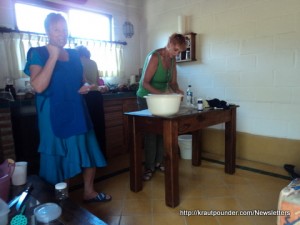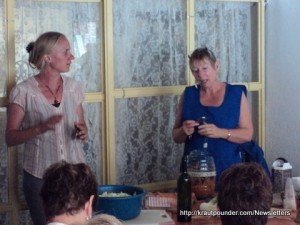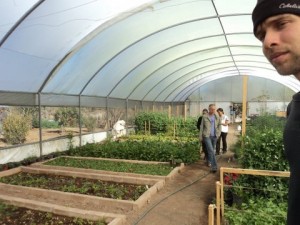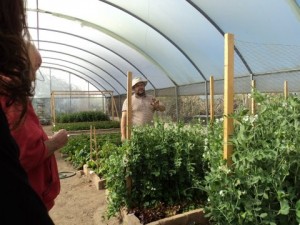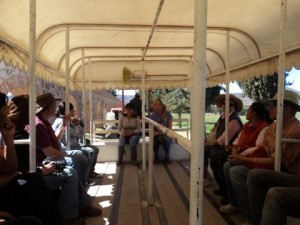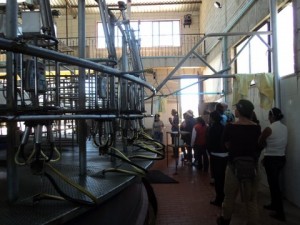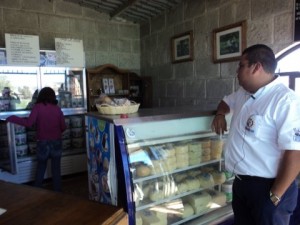Our co-chapter leader, Victoria Schneider, and her husband Tom, are currently living in Mexico. Here Victoria shares with us her wonderful experience of teaching a fermented foods class in Mexico.
 Looking across the room of eager faces, both Mexican and non-Mexican was wonderful. They sat in quiet attention as I began the class, starting of course, with the timeless work of our own Weston A Price. Here in Mexico I explain, the country farmers and poor villagers who have adhered to their age old traditions have beautiful teeth “as straight and white as piano keys”. Still today, this is often the case and they nod in agreement. This is because, I explain, they soak their whole corn in limestone water. This releases a form of calcium called calcium hydroxide into the water and some of the little stones remain in the corn. By soaking the whole corn seed, the phytates are deactivated. Then they grind the soaked corn by hand or in the village grinder into Masa Harina
Looking across the room of eager faces, both Mexican and non-Mexican was wonderful. They sat in quiet attention as I began the class, starting of course, with the timeless work of our own Weston A Price. Here in Mexico I explain, the country farmers and poor villagers who have adhered to their age old traditions have beautiful teeth “as straight and white as piano keys”. Still today, this is often the case and they nod in agreement. This is because, I explain, they soak their whole corn in limestone water. This releases a form of calcium called calcium hydroxide into the water and some of the little stones remain in the corn. By soaking the whole corn seed, the phytates are deactivated. Then they grind the soaked corn by hand or in the village grinder into Masa Harina
. This they mix with Manteca or pork fat and finally, press them into tortillas and cook them on the top of their stoves. This combination of soaked corn with limestone releases minerals and mixed with healthy pastured pork fat make perfect food to build healthy bones and beautiful teeth! I have the opportunity to tell them about the dangers of rancid fats that are in margarine and salad dressing and how healthy grass fed pork fat is. The Mexicans especially look surprised, but then the stories of how their grandmothers cooked came out. I ask them how old their grandparents lived to be, eating all this “bad” fat. Many said into their 80’s and 90’s. I tell them of my own grandmother who lived to almost 104. I share how she loved her high fat chicken wings, organ meats and cod liver oil and that she never once had her cholesterol checked! I tell them the greatest threat to Mexicans is not fat, but sugar. I launch into my sugar as the main enemy and the root cause of heart disease, cancer but especially diabetes. The nodding continues.
I also share with them how their ancestors made tamales, wrapping them in soaked corn husks, cooking them and packing them into clay jars. The jars were then buried in the ground and left to ferment for 2 weeks. The result was a delicious corn fungus that coats the tamales like a cheese. Again I get a room full of nodding Mexican and the Gringos look at me with skepticism; corn fungus! Yes, I say, it is delicious and when I see it on a menu, I always order it. I shared all this with my students, most of which were middle class Mexicans who have seen the beautiful teeth on the poor villagers who obviously have no money for dental care. I wanted them to understand why we value the traditions of our ancestors and to look back for solutions, rather than buying into modern foods of commerce.
My booklet of collected fermented foods was translated into Spanish, complete with a photo of Dr. Price. After this introduction of traditional foods of Mexico, I launch into the many benefits of eating fermented foods, also included in their booklet. Finally, we begin cutting, chopping, mixing and explaining the how one creates the magic of fermented foods.
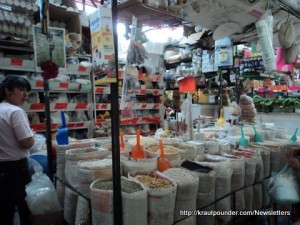 At our fermented foods classes in Oregon, my Co-chapter leader, Lisa Bianco-Davis and I always share samples of what we teach, and here in Mexico I made no exception. To accomplish this, I had to start my scavenger hunt in advance. This included a week long quest to find all the things one needs to make fermented foods; a sharp knife, large bowl, glass jars, spices, fresh organic vegetables and in-season fruit, and since I hadn’t brought my Kraut Pounder along, I would need a pounder. It was an adventure that took me through the many small markets and specialty stores challenging my growing ability to speak in Spanish with the shop owners.
At our fermented foods classes in Oregon, my Co-chapter leader, Lisa Bianco-Davis and I always share samples of what we teach, and here in Mexico I made no exception. To accomplish this, I had to start my scavenger hunt in advance. This included a week long quest to find all the things one needs to make fermented foods; a sharp knife, large bowl, glass jars, spices, fresh organic vegetables and in-season fruit, and since I hadn’t brought my Kraut Pounder along, I would need a pounder. It was an adventure that took me through the many small markets and specialty stores challenging my growing ability to speak in Spanish with the shop owners.
In the large public market, where I was directed to find all the spices, I encountered a mother and her two young sons working together in their small but bursting-to-the-seams store. Piled around the outside edge were large burlap sacks of every kind of seed and bean one could image, a wall of jars filled with herbs lined across the back wall, plants hanging from the wooden rafters completed the sense of earthy, wild but edible foods. The market itself is full of brilliant colors and aromas and the herb store alone was a delight for the senses. In my best Spanish, I politely asked the boy of about 10 years, for coriander, fennel, cumin, green pepper corns, chili flakes and on and on…. Yes, he says, how much do you want of each? O lordie, here we go, liters! He is patient and kind as I struggle through my list, translating carefully which constitutes major mental gymnastics for me. Finally, the paying part, which I continue to struggle through as the translation of numbers is challenging. The total is astonishingly cheap: under $4.00!
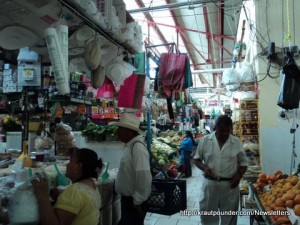 A few stalls further on and I spy what looks like a perfect “pounder”. It is a small stone cone with a rounded bottom, made for grinding in a stone bowl with 3 legs. I hold it in my hand and it feels just right, it feels like it would comfortably crush whatever I put beneath it. I ask again, in my best Spanish, how much it costs. She tells me $40 pesos or just under $4.00. I hesitate because we travel very light and it is pretty heavy being made of stone. She smiles and says how about $35 pesos. I smile and tell her it is perfect for my project. Then I bravely launch into a conversation about fermented foods and how I will be using it to make Mexican sauerkraut called Cortido with cabbage, chilies, onions, carrots and spices. I show her the many spices I had just purchased from the lovely woman and her two sons. She knows them. I tell her I will be teaching a class on April 1st at Via Organica. She is patient and kind and seems to understand me. We stick to the formal language of mutual respect as she wraps my stone pounder in newspaper and hands it to me with a warm smile.
A few stalls further on and I spy what looks like a perfect “pounder”. It is a small stone cone with a rounded bottom, made for grinding in a stone bowl with 3 legs. I hold it in my hand and it feels just right, it feels like it would comfortably crush whatever I put beneath it. I ask again, in my best Spanish, how much it costs. She tells me $40 pesos or just under $4.00. I hesitate because we travel very light and it is pretty heavy being made of stone. She smiles and says how about $35 pesos. I smile and tell her it is perfect for my project. Then I bravely launch into a conversation about fermented foods and how I will be using it to make Mexican sauerkraut called Cortido with cabbage, chilies, onions, carrots and spices. I show her the many spices I had just purchased from the lovely woman and her two sons. She knows them. I tell her I will be teaching a class on April 1st at Via Organica. She is patient and kind and seems to understand me. We stick to the formal language of mutual respect as she wraps my stone pounder in newspaper and hands it to me with a warm smile.
Finally ready, I constructed, in my very tiny kitchen apartment, cortido, sauerkraut with juniper berries, beet kvass, ginger carrots and apple and pear chutney. I made enough of each to sell after the class as this was a fund raiser for Via Organica Finding a way to fit it all into our refrigerator was a jig saw puzzle!
April 1st, begins with a fresh breeze in the air, but promises to be blisteringly hot by noon. It is the dry, hot season here now. The summer rains are still a month or two away and already are yearned for. Students begin arriving before the hour, which is unexpected. We give out the booklets, serve them a cold glass of keifered Hibiscus tea without sugar and direct them to their seats.
By all counts, the class was a big success. There are about 30 students and we shared pounding the cabbage, cutting the veggies, mixing the salt and spices. I have a translator and the cadence of our talking meshes well. People are nodding, smiling and enjoying the many samples I have provided. Questions are constant, as always. I try to answer as many as I can in Spanish, then remember I have to translate back to English!
We run over time, no surprise, but only a few leave. The questions continue as we make our final touches of sliding long thin sliced carrots around the outside of the jars, just for the beauty of it. The Mexicans love this. Everyone does. We clean up our mess, as people file out. They buy almost every one of the products made available. We count our money, deduct expenses and feel more than pleased with the money we were able to raise for Via Organica. I am surprised and delighted when presented with a beautiful pair of hand-made silver earrings!
Running off this success, when later I traveled into the mountains near Guadalajara, where I have been blessed to work in a magical healing spa known as Rio Caliente, I again offered to teach another class on Fermented Foods. Over the last 10 years, I have worked as a BioResonance therapist using the Bicom device when the resident therapist needs to travel.
It turns out, the whole kitchen staff, all from the local village, wants to learn how to make fermented foods, as does many of the visitors to the spa. I am very pleased by this news as the spa is all inclusive including the vegetarian only menu. Several years back I spent time, politely explaining the dangers of soy to the owner. Today, very little soy is used in the recipes. Adding the knowledge of how to create fermented foods to the menu is an exciting possibility. Sadly, in the end, the whole kitchen staff hold a silent protest and refuses to take the class due to a labor dispute with the owner of the spa. But still many of the staff outside the kitchen and visitors are thrilled and our plans continue.
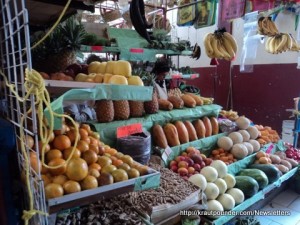 We had a small group of only 12, but we made all the recipes from the booklet. I managed to save and pack with me to Rio Caliente samples of Cortido, Ginger Carrots and Keifer water for tasting. In the Fruit Chutney recipe, I decided to use local fruit instead of apples and pears. Mango’s are in season now and absolutely divine. So we mixed mangos, pineapple with small bite sized jicama for texture. All the information was well received and everyone went home happy. Later, I received an email morning, the Mango and Pineapple Chutney was excellent!
We had a small group of only 12, but we made all the recipes from the booklet. I managed to save and pack with me to Rio Caliente samples of Cortido, Ginger Carrots and Keifer water for tasting. In the Fruit Chutney recipe, I decided to use local fruit instead of apples and pears. Mango’s are in season now and absolutely divine. So we mixed mangos, pineapple with small bite sized jicama for texture. All the information was well received and everyone went home happy. Later, I received an email morning, the Mango and Pineapple Chutney was excellent!
It brings me great pleasure to share this traditional knowledge with the local people; however they end up using it. I can imagine Dr. Price smiling from above as we continue to teach, to teach, to teach.
How to make tortillas: http://simplyrecipes.com/recipes/how_to_make_corn_tortillas/
What is Jicama: http://www.youtube.com/watch?v=Jg_a5lGUqg4


